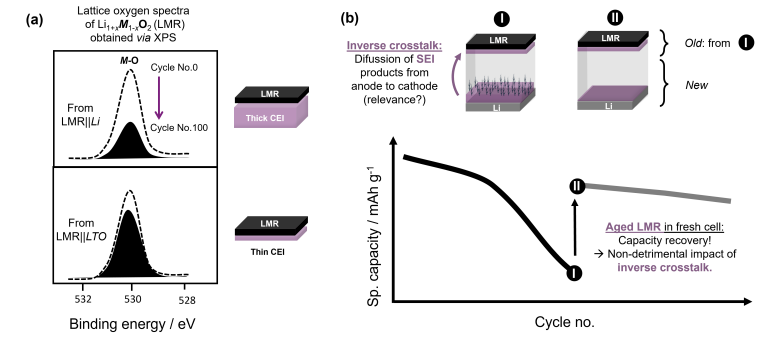Buildup of Cathode-Electrolyte Interphase without Relevant Influence on Cell Capacity
Lithium/manganese-rich layered oxides (LMR) are considered a promising cathode material for high-energy lithium-ion batteries. In addition to the classic redox activity of the transition metals, the capacity is also obtained from the redox activity of the oxygen. However, full capacity utilization can lead to cell degradation, for example through electrolyte oxidation and transition metal dissolution.
A research team from MEET Battery Research Center at the University of Münster has now investigated the effects of the buildup of a cathode-electrolyte interphase (CEI) on cell aging and performance in more detail. Such CEI accumulation can not only be caused by cathode-electrolyte reactions, but also by “inverse” crosstalk, i.e., the accumulation of soluble solid electrolyte interphase components (SEI) that diffuse from the lithium metal anode. The study examined battery systems in which electrolytes and separators were used according to the state-of-the-art (SOTA).
Limited Effects of CEI Accumulation on Cell Degradation
With their study, the researchers aimed to identify possible oversights in the attribution of capacity fading mechanism in high-voltage LMR || Li cells, which are commonly used to evaluate the performance of LMR cathodes. “Our study has shown that there is only a limited impact of CEI accumulation on capacity reduction, provided state-of-the-art separators and electrolytes are used. This shows us that CEI buildup is surprisingly quite benign in high-voltage LMR || Li cells,” MEET scientist Anindityo Arifiadi explains the results.

This is in contrast to another recent study, which claims to have found deteriorating effects of “inverse” crosstalk on the capacity retention of LiFePO4 || Li cells with even lower operating voltages. Dr Johannes Kasnatscheew, Head of the Research Division Materials at MEET Battery Research Center, explains: “The contrasting results of the current research highlight the large differences in CEI properties, which are strongly influenced by cell chemistry and the cell components used, e.g., separators and electrolytes.”
Entire Study Online Available
Detailed results of the study have been published by the authors Anindityo Arifiadi, Feleke Demelash, Niklas M. Abke, Tobias Brake, Marc Vahnstiege, Lennart Alsheimer, Dr Simon Wiemers-Meyer and Dr Johannes Kasnatscheew, MEET Battery Research Center as well as Prof. Dr Martin Winter, MEET Battery Research Center and Helmholtz Institute Münster of Forschungszentrum Jülich, in the journal “Advanced Functional Materials”.

